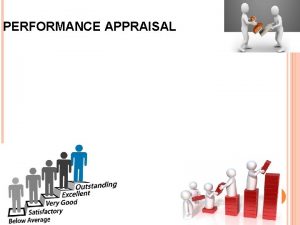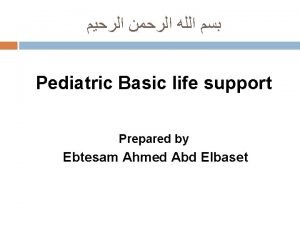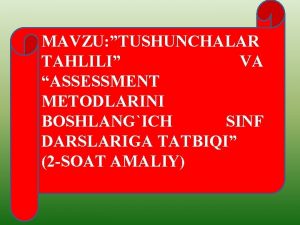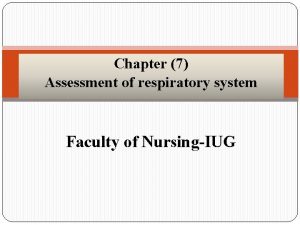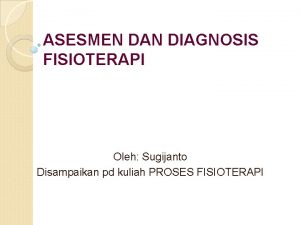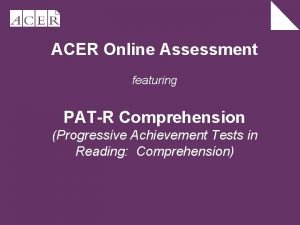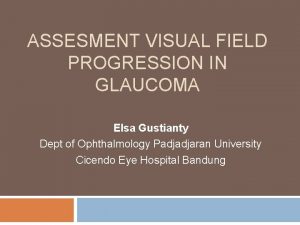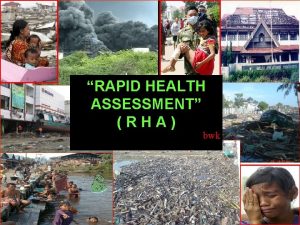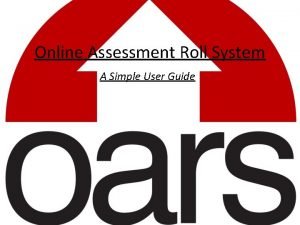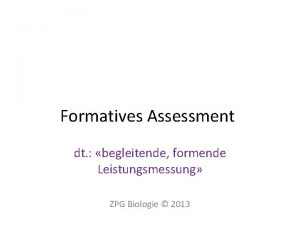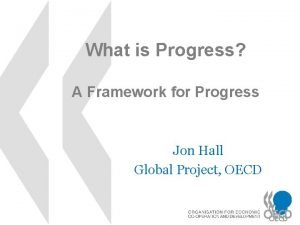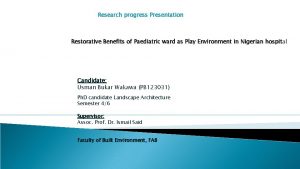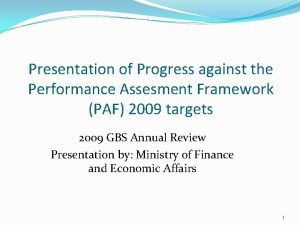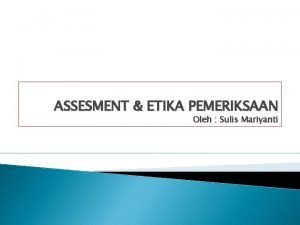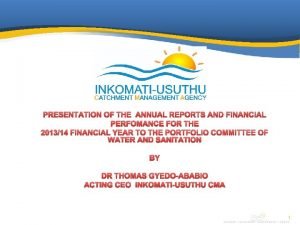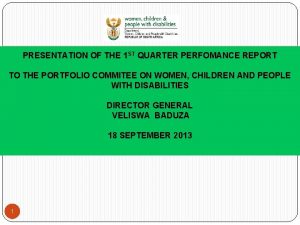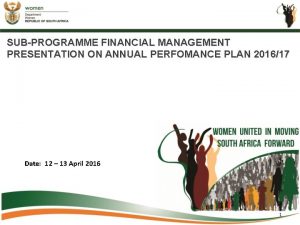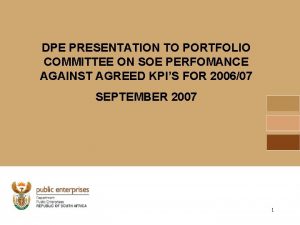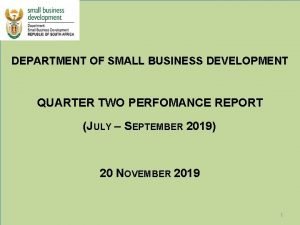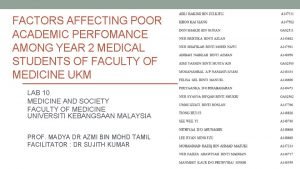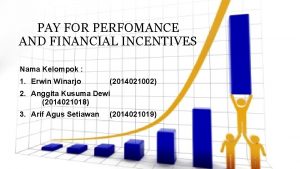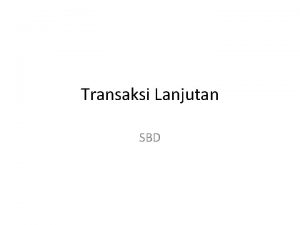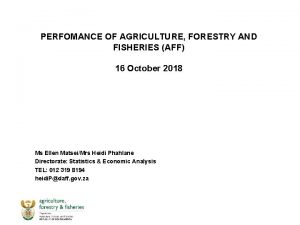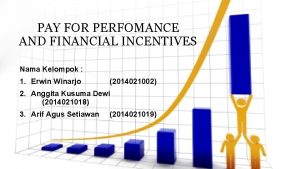Presentation of Progress against the Perfomance Assesment Framework































- Slides: 31

Presentation of Progress against the Perfomance Assesment Framework (PAF) 2008 targets 2008 GBS Annual Review Presentation By: Ministry of Finance and Economic Affairs

OUTLINE l l l l Background PFM-Monitoring Framework and Reporting PAF Matrix Overall Assessment Underlying Processes: Sector reviews Temporary Process Actions Outcome Indicators Conclusion

1. Background GBS is governed by the Partnership Framework Memorandum (PFM) of January 2006 § PFM sets out the principles and terms between the Government and GBS-DPs regarding the provision of GBS § Specifically PFM outlines, underlying principles for GBS partnership arrangement, responsibilities for the Govt and GBS-DPs, dialogue arrangements; monitoring, evaluation and reporting arrangements; as well as arrangements for disbursements, auditing and procurement §

Background (cont) Underlying principles relate to the following: ü continuing sound macroeconomic policies and management; ü commitment to achieving MKUKUTA objectives and MDGs; ü sound budgeting and public financial management systems; ü continuing peace and respect for human rights, the rule of law, democratic principles, and the independence of the judiciary; and ü good governance, accountability of the Government to the citizenry, and integrity of public life, including the active fight against corruption. § Their observance is critical for the continuation of the partnership agreement §

Background (Cont) § PFM-Government responsibilities relate to: ü the use of GBS funds for MKUKUTA implementation; ü implementation of the commitments that are jointly agreed in the PAF Matrix; ü budget allocation to economic growth and poverty reduction commitments and full accounting for the use of funds; ü monitoring and reporting on MKUKUTA implementation; ü strengthening of public financial management; ü open dialogue; and ü GBS Annual Reviews under Government leadership.

Background (Cont) PFM-GBS DPs responsibilities relate to: ü the establishment of an agreed disbursement schedule; ü maintenance of a GBS Partners’ decision making structure; ü GBS disbursements in line with the Government budget cycle, frontloaded in the first half/first quarter of the FY; ü Increased/improved aid predictability ü improved overall harmonisation of DPs processes and requirements, including joint missions or analytic work etc. ; ü provision of demand-driven TA and capacity building support to the Government; ü participation in the GBS Annual Review; and ü delivery of more aid through the GBS funding modality.

2. PFM-Monitoring Framework and Reporting The Go. T and GBS Partners have jointly agreed to keep track of their performance relative to jointly agreed actions, targets and indicators l Agreed to have a jointly Government – GBS Partner joint Annual Review of GBS performance timed to align with Go. T budget cycle and facilitate the preparation of the Budget Guidelines l Information and analysis of the annua review will be drawn primarily from the MKUKUTA monitoring system, and other underlying review processes outlined in the PAF. l

3. What is PAF Matrix o PAF Matrix is the framework to assess Government performance on an annual basis for the provision of GBS funding o It contains Government commitments that have been jointly agreed between the Government and GBS – DPs o GBS-DPs decide their GBS funding commitments on the basis of Government performance against the PAF o All GBS-DPs commonly use the PAF as the basis for their funding decisions – no individual/separate criteria

What is PAF Matrix l PAF Matrix commitments are grouped into four areas: – 1) Growth and Reduction of Income Poverty; 2) Improvement of Quality of Life and Social Wellbeing; 3) Governance and Accountability); 4) Public Financial Management and Macroeconomic Stability, including Public Expenditure Management

What is PAF Matrix (Cont) Issues to monitor: l Cluster 1 - Is broad based economic growth being effectively promoted? Are policy debates /decisions transparent? l Cluster 2 - Is there improved quality of life? Is service delivery improving? l Cluster 3 -Is good governance and the rule of law ensured? Is government accountable to the people? l Cluster 4&5 -Does the budget reflect national policy? Does spending reflect the budget? Are budgetary decisions questioned for consistency with policy and Value For Money? Are there systems in place within Go. T to assess the regularity of expenditures? Is the procurement system open and transparent and provide value for money?

PAF Matrix (cont) l l Commitments listed in the PAF Matrix are grouped into three categories: Underlying processes; ¡ usually sector or programme reviews. These reviews consist of an ongoing process of dialogue between the Government, DPs and other stakeholders throughout the year and usually with an annual (or semiannual) multi-stakeholder review event l Temporary process actions ¡ l are specific actions that the Government commits itself to complete by a specified timeframe before the GBS Annual Review at which Government performance is assessed. Outcome indicators ¡ ¡ indicators measure broader outcomes in the five areas of the PAF and in most cases are taken from the MKUKUTA Monitoring System. They have baseline values for 2005 and targets for 2010, corresponding to the MKUKUTA targets wherever applicable Progress towards these targets are assessed annually – it is determined whether progress is on track, already achieved, is at risk of being achieved by 2010, or progress is off track

2008 PAF l The 2008 PAF has: ¡ 31 TPAs ¡ 34 Outcome Indicators ¡ 23 Underlying Processes

4. Overall Assessment process for performance against PAF 2008 has been completed l 22 out of 23 Underlying Processes have taken place in this year’s cycle and assesed as SATISFACTORY. l 19 out of 31 TPAs have been achieved l 16 out of 34 Outcome Indicators are On Track, 5 are not assesable due to unavailability of data and 13 are Off Track l

Overall Assessment (Cont) Simplify Go. T budget structure to make central local transfers more transparent, easy to monitor and on time TPA is assesed as Not Achieved by DPs l Local Government Reform Programme underlying process DPs assesment unsatisfactory with positive trends in certain aspects. l NACSAP II underlying process DPs assesment undecided pending annual review l Public Financial Management Reform Programme DPs assessment Satisfactory with areas of concern l

5. Underlying Processes: Sector reviews l l l 96% of the underlying processes are Satisfactory Reviews in several of the key MKUKUTA sectors such as health, infrastructure, education, agriculture and water have all been rated as ”satisfactory”. Of the four core reforms (legal, local gov, Public service, Public financial management) two has been reviewed this year. Public service reform was rated satisfactory the legal sector (LSRP) review was rated ”unsatisfactory with a clear positive trend”. Local Government Reform was not reviewed but progress is rated as satisfactory Another cross-cuting reform area has been rated as unsatisfactory (BEST programme)

6. Temporary Process Actions achieved 61% of Temporary Process Actions are achieved In Cluster 1, ”Growth and Reduction of Income Poverty”, 8 out of 13 TPAs have been achieved, 1 not assesable. l In Cluster 2, ”Improvement of Quality of Life and Social Well-being”, 5 out of 7 TPAs have been achieved l In Cluster 3, ”Governance and Accountability”, 3 out of 6 TPAs were achieved l In Cluster 4/5 ”PFM/Macro”, 3 out of 6 TPAs were achieved l l

8 TPAs achieved in Cluster 1 l l l l Production of Poverty Estimates (HBS) and the launch of a National Panel Survey that will provide annual poverty data; Submission of the Electricity Bill to Parliament; Further progress in implementation of TANESCO’s financial recovery plan Framework for PPP in the entire transport sector finalized and approved Approval of Programme Implementation Document for a Study for Diagnostic Trade Integration Study (DTIS) Collect information and report on systems of licenses/concession allocations in the natural resources Government adopts the Power System Master Plan by September 2008 Establish TANROADS Board based on the Roads Act by end February

4 TPAs Not Achieved in CWG 1 Power Sector Reform Strategy adopted by Government by March 2008. l Road Safety Policy adopted by the Government by January 2008 and Road Safety Board in place by July 2008 l Business Activities Registration Act subsidiary regulations consistent with one-stop-shop good practice approved by April 2008 l Amendment of Legislation for all Crop Boards by June 2008 l

5 TPAs achieved in Cluster 2 l l l A preliminary State of Environment reporting system in place before GBS Annual Review 2008 Updating the 2006/07 Health Sector Performance Report by January 31, 2008 Health Sector Performance Report for 2007/08 produced and disseminated by end August 2008. By September 2008, agree on education sector performance report on the basis of an agreed sector monitoring tool By January 2008, agreement on a calendar of key education sector meetings

2 TPAs Not achieved in Cluster 2 l National Social Protection Framework adopted by Government by June 2008 l Submission to Parliament of Water Bill by end of first quarter 2008

3 TPAs achieved in Cluster 3 l Development of a capacity development programme for the Legal Sector Reform Programme (LSRP). l A minimum of 5 grand corruption cases are either ready for prosecution or have been dismissed for reasons which have been made public. l Simplification of Go. T budget structure to make central local transfers more transparent, easy to monitor.

3 TPAs not achieved in Cluster 3 Pay Reform: A revised Medium-Term Pay Policy is adopted by Government by December 2008 as the basis for reform of pay and allowances. A Draft was available by October 2008 as scheduled in PAF 2008. l Government to implement the MTS Coordination and Monitoring Structure for the Legal sector reform programme as agreed with the Legal Sector Group l Fast track harmonisation of channels of funding to LGAs from central government, DPs and NGOs. l

3 TPAs achieved in Cluster 4/5 Translate new PFMRP Strategic Plan into Annual Plan for 2008 -09 and present at JSC of April 2008 l Government to provide structured reply to the latest NAO report l Approval granted by October 2008 to create a new Department of Internal Audit in the Ministry of Finance l

3 TPAs not achieved in Cluster 4/5 Carry-out post-implementation review of IFMS by October 2008 provided funds are made available l Regulations under the Procurement and Supplies Professional Board Act prepared and issued (gazetted) by October 2008 l Road map to be presented at the JSC in April 2008 on how to reach Internal Audit Standards by 2015 l

7. Outcome indicators in PAF 2008 For the first time, PAF 2008 included annualised targets l This enables the assessment of progress towards achieving MKUKUTA targets each year l It is expected the PAF 2009 annual targets will be included for all indicators l Out of 29 assesed outcome indicators 16 are on track which is 55% of the assesed indicators l

16 Outcome Indicators on track – 2008 PAF l l l l Regional roads in good and fair condition % of rural roads that are passable (good and fair condition) % of solid waste collected in DSM (amount collected) No. of districts qualifying for agricultural grants Child vaccination (diphteria, pertusis, tetanus, Hepatitis B) Sustaining the high (80%) Tuberculosis treatment rate Sustaining the HIV prevalence rate (15 -24 years group)

16 outcome indicators on track – 2008 PAF (Cont) l l l l l NAO on its way to achieve level 3 in AFROSAI by 2010 Target for budget expenditure outturns Target for the fiscal deficit as % of GDP Transition from Standard VII to Form I Gross Higher enrolment rate TB Treatment Completion Rate Qualified teacher/pupils ratio Number of Grand Corruption cases prosecuted as a % of invastigated cases proposed by PCCB to the DPP Approved budget broadly in line with policy objectives (MKUKUTA, sector policies)

10 Outcome indicators off track l l l l % of population with access to electricity Total electricity generating capacity and utilization Time Taken for Import Container from off – loading until clearing from port Reduction of income poverty in rural population (measured by annual agriculture GDP growth) Enabling environment for private sector lead growth improved as reflected in “Doing Business” ranking Net primary school enrolment Percentage of the population that has access to clean and safe water from a piped or protected source Proportion of children under 2 years that receive three doses of vaccine against diphtheria, pertussis, tetanus and Hep B

10 Outcome indicators off track Proportional of Births Attended by a Skilled Health Workers l Percentage of total government budget allocated directly to LGAs which does not go through ministerial votes and is calculated on a formula basis l

Summary Overall performance of the 2008 PAF shows good progress compared to last year. l The review process started much earlier with strong ownership and leadeship of the Go. T l All targets which could not be achieved have good explanation provided in the Cluster Reports l The GBS AR will provide further guidance on the wayforward to meet challenges faced during the 2008 GBS review process l

Asanteni sana!
 Define performance appraisal
Define performance appraisal Caf social services
Caf social services Physical progress and financial progress
Physical progress and financial progress Pat pediatric assessment
Pat pediatric assessment Assesment in lesson plan
Assesment in lesson plan Tushunchalar tahlili
Tushunchalar tahlili It assesment
It assesment Chapter 7 assesment
Chapter 7 assesment Diagnosis fisioterapi
Diagnosis fisioterapi Pat r test
Pat r test Hirarc process flow
Hirarc process flow Essensial assesment
Essensial assesment Yang merupakan fungsi rapid health assessment adalah
Yang merupakan fungsi rapid health assessment adalah Informative assessment
Informative assessment Assessment roll
Assessment roll Strategi penilaian
Strategi penilaian Indiana assessment portal
Indiana assessment portal Zpg biologie 2018
Zpg biologie 2018 Wireless assesment
Wireless assesment Ecological risk assesment
Ecological risk assesment Progressjon
Progressjon Research progress presentation
Research progress presentation Dispositional framework vs regulatory framework
Dispositional framework vs regulatory framework Theoritical framework example
Theoritical framework example Conceptual framework maker
Conceptual framework maker Conceptual framework theoretical framework
Conceptual framework theoretical framework Dispositional framework vs regulatory framework
Dispositional framework vs regulatory framework Theoretical framework
Theoretical framework Hát kết hợp bộ gõ cơ thể
Hát kết hợp bộ gõ cơ thể Lp html
Lp html Bổ thể
Bổ thể Tỉ lệ cơ thể trẻ em
Tỉ lệ cơ thể trẻ em
